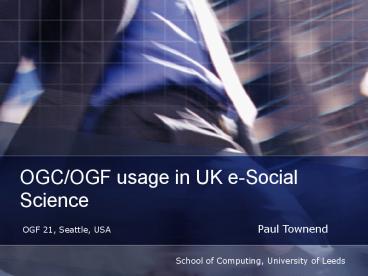OGCOGF usage in UK eSocial Science - PowerPoint PPT Presentation
1 / 19
Title:
OGCOGF usage in UK eSocial Science
Description:
OGC/OGF usage in UK e-Social Science. OGF 21, ... Geospatial data in e-Social Science. Why it is important. Example node: MoSeS ... Examples of things ... – PowerPoint PPT presentation
Number of Views:44
Avg rating:3.0/5.0
Title: OGCOGF usage in UK eSocial Science
1
OGC/OGF usage in UK e-Social Science
OGF 21, Seattle, USA Paul Townend
School of Computing, University of Leeds
2
Introduction
- What is e-Social Science?
- National Centre for e-Social Science
- Use of geospatial data
- Why this is important for e-Social Science
- MoSeS
- Why standards?
- Use of OGC standards
- Use of Grid standards
- OGC/OGF standards from an e-Social Science
perspective
3
What is e-Social Science
- e-Science is large scale science carried out
through distributed global collaborations enabled
by the Internet. - e-Social Science is the application of e-Science
concepts to social science problem domains. This
uses the Internet, software tools and structured
information for collaborative work.
4
National Centre for e-Social Science
- The UK National Centre for e-Social Science
(NCeSS) was founded by the UK Economic and Social
Research Council (ESRC) - It aims to investigate how Grid technology
developed under the UK e-Science programme can
benefit the social sciences. - The centre consists of a coordinating Hub (Uni of
Manchester), seven Research Nodes, and twelve
Small Grant projects.
5
Use of geospatial data
- Examples in NCeSS?
6
Geospatial data in e-Social Science
- Why it is important
7
Example node MoSeS
- MoSeS (Modelling and Simulation for e-Social
Science) is a research node of NCeSS. - MoSeS provides a suite of modeling and simulation
tools grounded in a series of well-defined policy
scenarios.
8
Aims of MoSeS (1)
- MOSES has four high-level aims.
- 1) To create a flagship modelling and simulation
node, in which the capabilities of Grid Computing
are mobilised to develop tools whose power and
flexibility surpasses existing and previous
research outputs. - 2) To demonstrate the applicability of
grid-enabled modelling and simulation tools
within a variety of substantive research and
policy environments.
9
Aims of MoSeS (2)
- MOSES has four high-level aims.
- 3) To provide a generic framework through which
grid-enabled modelling and simulation might be
exploited within any problem domain. - 4) To encourage the creation of a community of
social scientists and policy users with a shared
interest in modelling and simulation for e-social
science problems.
10
Aims of MoSeS (3)
- There are an abundance of simulation games
relating to people, cities and societies (past,
present and future). - MoSeS poses the question of what would be the
impact of transferring these simulations into a
real world environment. - Supposing that computational power and data
storage were not an issue, what would you build?
11
MOSES vision
12
MOSES architecture
13
Screenshots
14
Screenshots
15
Screenshots
16
Why standards?
- Preaching to the choir? I think a few paragraphs
will do. Will add them soon.
17
Use of OGC standards
- MoSeS WPS? Geolinking
- Geo-VUE
- Other UK projects
18
Use of Grid standards
- MOSES is hard... SRB? Could talk about future
WS-RF or similar for heavy computation - Other NCeSS projects?
19
OGC / OGF standards
- From an e-social science perspective, why do OGC
and OGF need to work together... - Examples of things that need to be done?































